The idea of rocket propelled aircraft originated in the automobile racing world and saw its first application on June 11, 1928, the first flight of a rocket-powered aircraft, the Lippisch Ente, in Germany. Following World War II, in the US, interest in rocket-propelled aircraft focused on better understanding of aerodynamics in the transonic regime. The X-1 rocket plane, flown between 1946 and 1958, and the first to break the sound barrier in 1947, led to new speed and altitude records. Flown between 1959 and 1968, the X-15 hypersonic rocket-powered research aircraft further expanded knowledge and experience to the edge of outer space, with speed records for piloted aircraft that stand to this day. Rocket-powered aircraft have found a place in today’s suborbital commercial space sector.
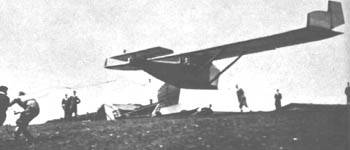
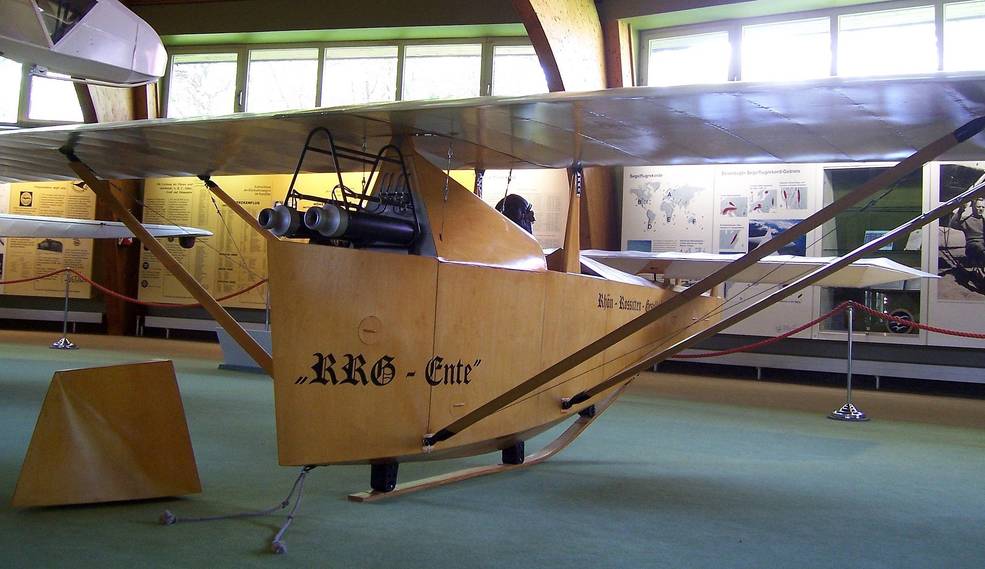
Left: The Lippisch Ente makes the first rocket-powered flight of a piloted aircraft. Image credit: Wikipedia. Right: A model of the Lippisch Ente rocket-powered aircraft showing the two rocket engines at the back of the aircraft, in the Deutsches Segelflugmuseum (German Glider Museum) in Wasserkuppe, Germany. Image credit: Courtesy Deutsches Segelflugmuseum.
The first rocket-powered piloted aircraft flight took place on June 11, 1928, the result of an unlikely collaboration among an automobile tycoon, two rocket pioneers, and an aircraft designer. Fritz von Opel, grandson of the German auto manufacturer of the same name, believed he could improve the company’s reputation by mounting rockets on its racing cars. He set a land speed record of 148 miles per hour in May 1928, driving a rocket-equipped car. Opel also believed that the future of aviation lay in rocket propulsion. He teamed with German rocket pioneers Friedrich Sander and Max Valier to realize his dreams. Opel purchased a glider manufactured by Alexander Lippisch and with Sander and Valier’s help, mounted two black powder rockets on the aircraft’s rear. Because the glider included a forward canard design, Lippisch named it Ente, German for duck, since canard is French for duck. The first test on June 11 failed when the rockets failed to ignite. On the second attempt, one rocket ignited as planned, the Ente lifted off, test pilot Fritz Stamer flying it for 4,900 feet before making a perfect landing, completing the first ever flight of a rocket plane. A third test, firing both rockets, did not go as planned, as one rocket fired perfectly but the second exploded. The damaged airplane took off on the power of the single rocket, but with its control surfaces not working and much of it aflame, Stamer barely escaped with his life while the Ente burned to ashes.
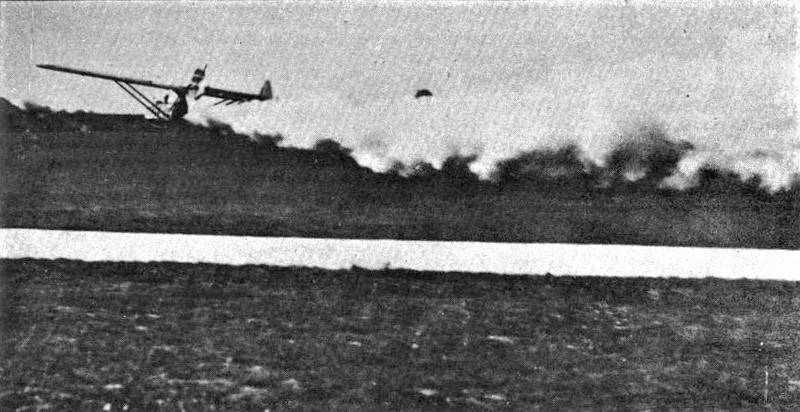
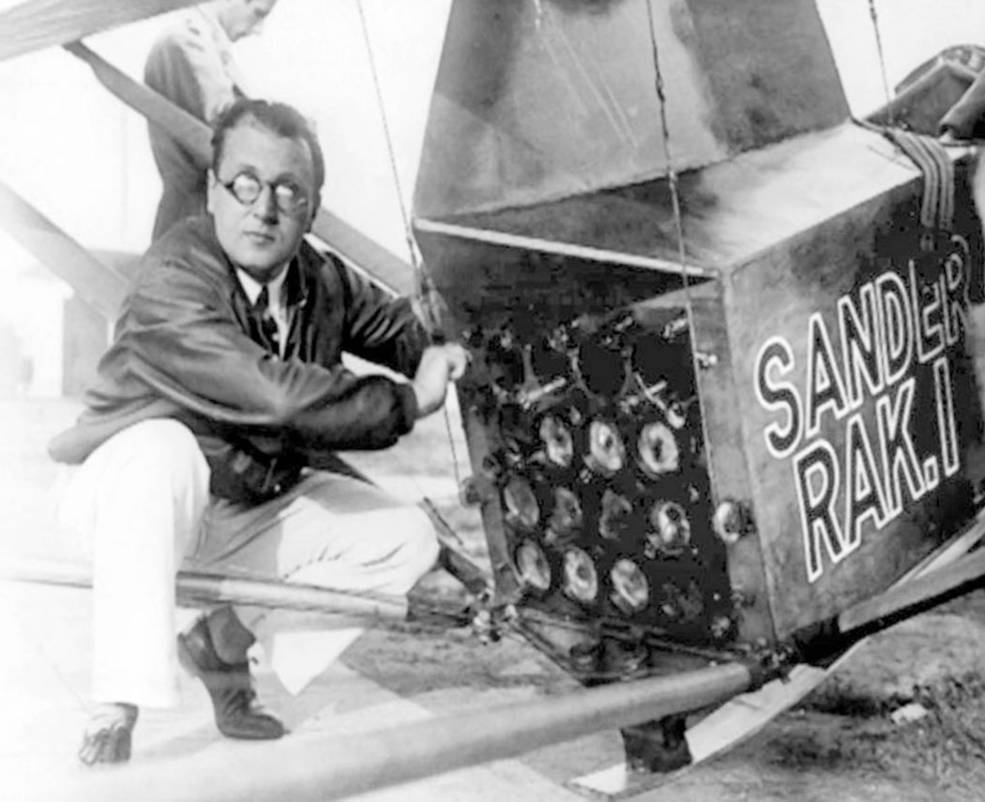
Left: The first public flight of a rocket powered aircraft, the Opel RAK.1, Sept. 30, 1929.Image credit: Wikipedia. Right: Fritz von Opel at the business end of the Opel RAK.1. Image credit: Trev Clark Obscure Aviation History.
Undaunted, Opel purchased another glider, with a more traditional configuration, and installed 16 rocket motors at the back. He named the world’s first purpose-built rocket plane the Opel RAK.1. On its first flight on Sept. 30, 1929, in front of an assembled crowd including news media, Opel flew it for 75 seconds, covering a distance of nearly one mile. After the rockets shut down, he came in for a hard landing, causing moderate damage to the aircraft. Opel turned his attention away from rocket-powered aircraft, and only a few others made similar attempts in the 1930s. During World War II, the German Luftwaffe applied rocket technology to two different aircraft. The Heinkel He 176, an experimental aircraft and the first powered solely by a liquid-fueled rocket, made its first flight on June 20, 1939. Although officially canceled just three months later, it offered many lessons learned for follow-on rocket-powered aircraft, such as the Messerschmitt Me 163 Komet interceptor, the first mass-produced rocket-powered aircraft, that entered service the near the end of the war. The short flying time provided by the rockets limited its operational usefulness. Japan built a few domestically produced copies of the Me 163 called the Mistubishi J8M Shūsui. With a first flight on July 7, 1945, they never saw combat.

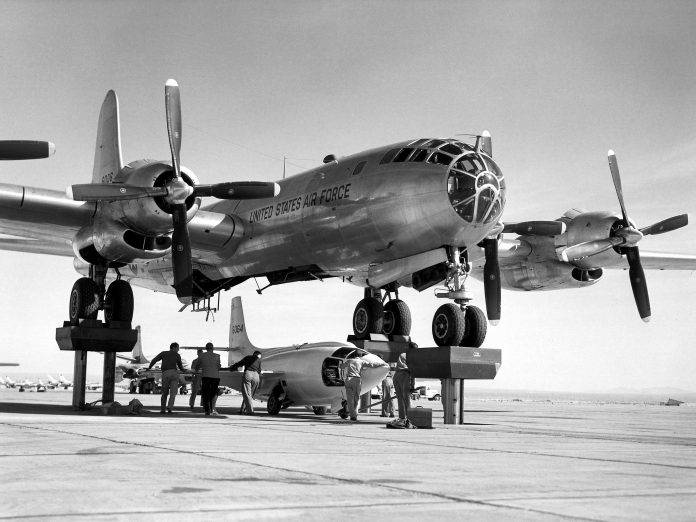
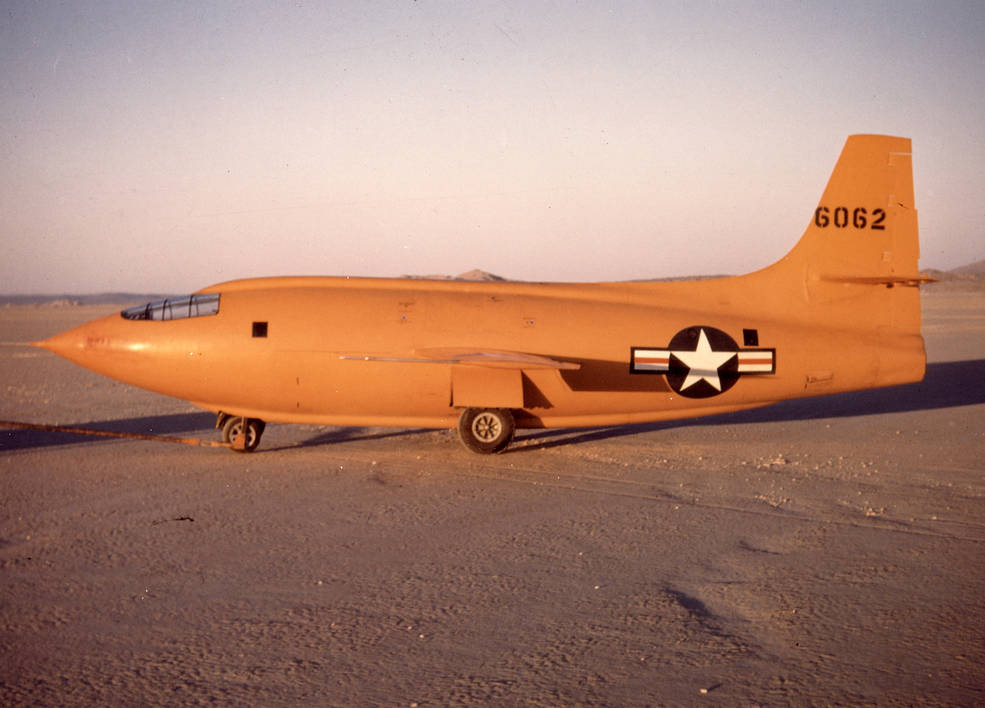
Left: U.S. Army Air Forces pilot Charles E. “Chuck” Yeager stands next to the Bell X-1 rocket plane he named “Glamorous Glennis,” after his wife, and in which he broke the sound barrier. Middle: Ground crews prepare to mount the X-1-3 rocket plane to the underside of a B-29 Superfortress bomber. Right: The Bell X-1 on the runway.
In the United States, interest in rocket-propelled aircraft began in the early 1940s in response to aerodynamic challenges airplanes began to experience as they neared the speed of sound (Mach 1). The National Advisory Committee for Aeronautics (NACA), NASA’s precursor agency, and the U.S. Army Air Forces (USAAF) jointly proposed to expand aviation research in the transonic regime (Mach 0.75 to Mach 1.2). On March 16, 1945, the Air Technical Services Command signed a contract with Bell Aircraft for the construction of three experimental aircraft to explore transonic research issues, ultimately designated the X-1. Under a separate contract, Reaction Motors Inc. designed and built the XLR-11 rocket engine, burning a mixture of alcohol and water with liquid oxygen as an oxidizer, to power the X-1. After a B-29 Superfortress bomber carried the X-1 to altitude, the rocket plane dropped away, lit its engine, and carried out its mission. Bell delivered the first of the three aircraft, designated X-1-1, in December 1945, with the first glide flight taking place at Pinecastle Field, Florida, on Jan. 19, 1946. Later that year, the X-1 program relocated to Muroc Field, now Edwards Air Force Base in California’s Mojave Desert. Following delivery of the second X-1 aircraft (X-1-2), in June 1947 the USAAF and NACA agreed on a two-phase flight program. The Air Force used X-1-1 to reach Mach 1 as quickly as possible while NACA used X-1-2 to make detailed studies in the transonic regime. After several flights that brought him closer and closer to Mach 1, on Oct. 14, 1947, USAAF pilot Charles E. “Chuck” Yeager took the aircraft to Mach 1.06, becoming the first human to break the sound barrier. On March 4, 1948, NACA pilot Herbert H. Hoover became the first civilian to break the sound barrier in the X-1-2 aircraft. Later flights in the X-1 program, using upgraded aircraft and fuel delivery systems, allowed Yeager to reach a maximum speed of Mach 2.44. The last flight of the X-1 program took place in November 1958. A total of 27 pilots flew different versions of the X-1, completing 238 flights.
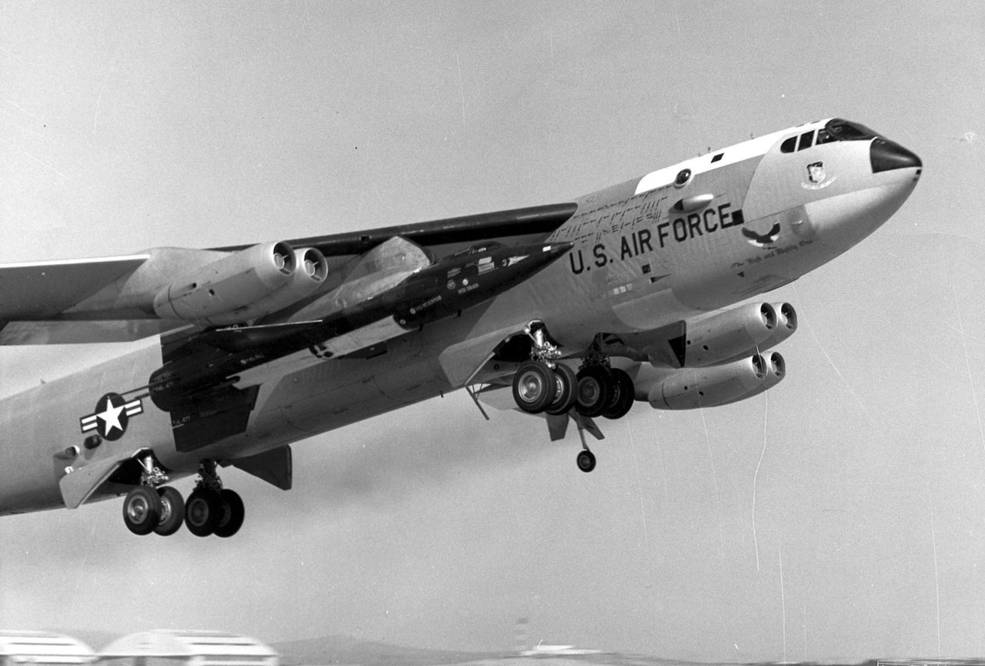
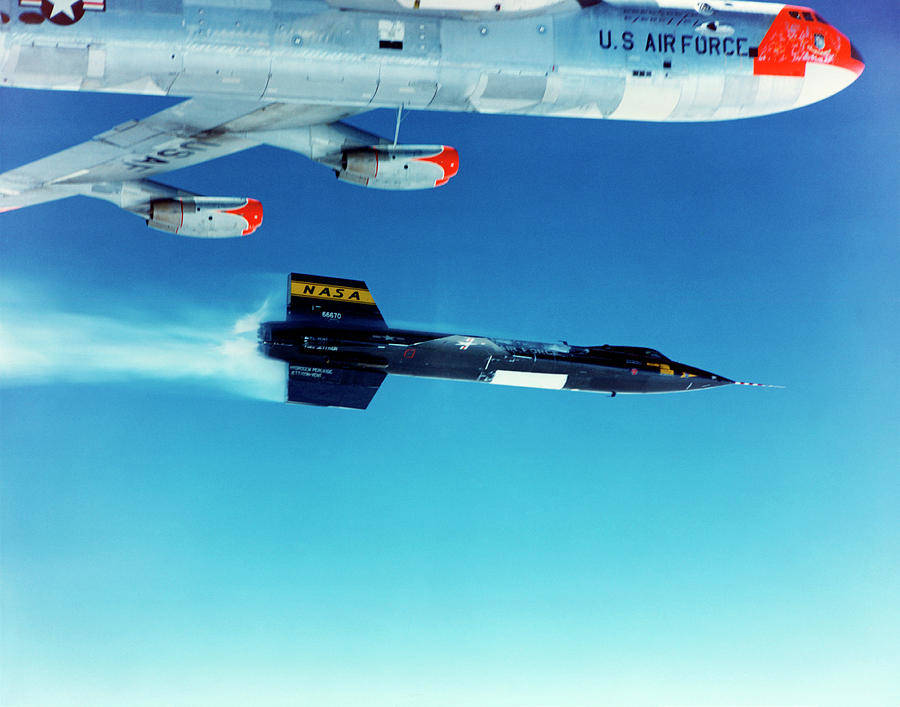
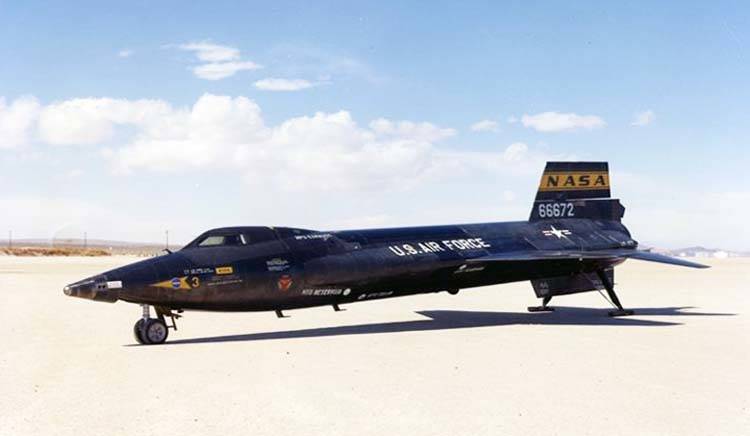
Left: A B-52 Stratofortress bomber carries an X-15 hypersonic rocket-powered research aircraft to altitude prior to deployment. Middle: An X-15 shortly after deployment from the B-52. Right: An X-15 on the lakebed runway at Edwards Air Force Base in California.
Between June 8, 1959, and Oct. 24, 1968, 12 test pilots completed 199 flights of the X-15, a hypersonic rocket-powered research aircraft jointly operated by NASA and the U.S. Air Force. The three X-15 aircraft built by North American Aviation sought to expand knowledge of aerodynamics in the hypersonic regime and at extreme altitudes. Similar to the X-1, a B-52 Stratofortress bomber released the X-15 at altitude and the pilot lit its rocket engine, manufactured by Reaction Motors and burning anhydrous ammonia and liquid oxygen. Flights in the X-15 program set numerous altitude and speed records, reaching the edge of outer space. U.S. Air Force pilot William J. Knight reached a speed of 4,520 miles per hour (Mach 6.7) on Oct. 3, 1967, a record that stands to this day for piloted powered aircraft. Although NASA chose to use vertical rockets and capsules to carry out its human spaceflight programs, the X-15 program contributed to the success of the Apollo Moon landing missions by providing critical data on how materials react to extreme conditions, on aerodynamic heating, and on the characteristics of reentry into Earth’s atmosphere.
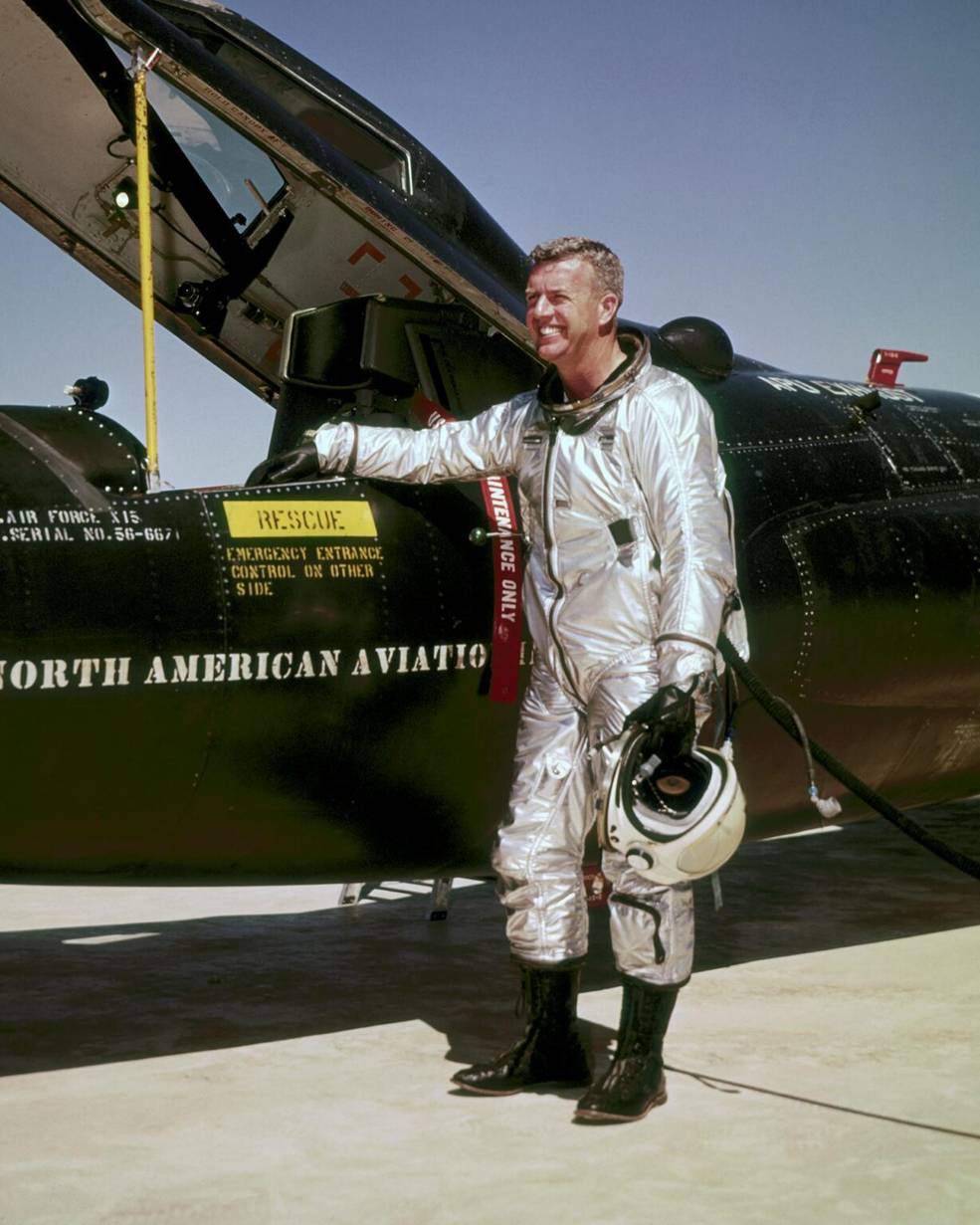
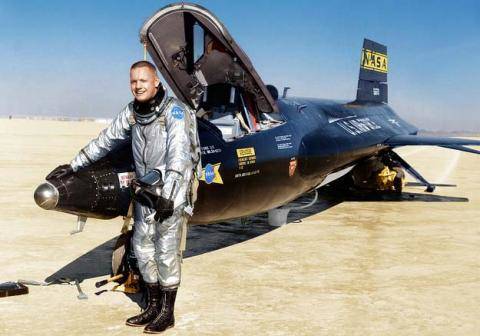
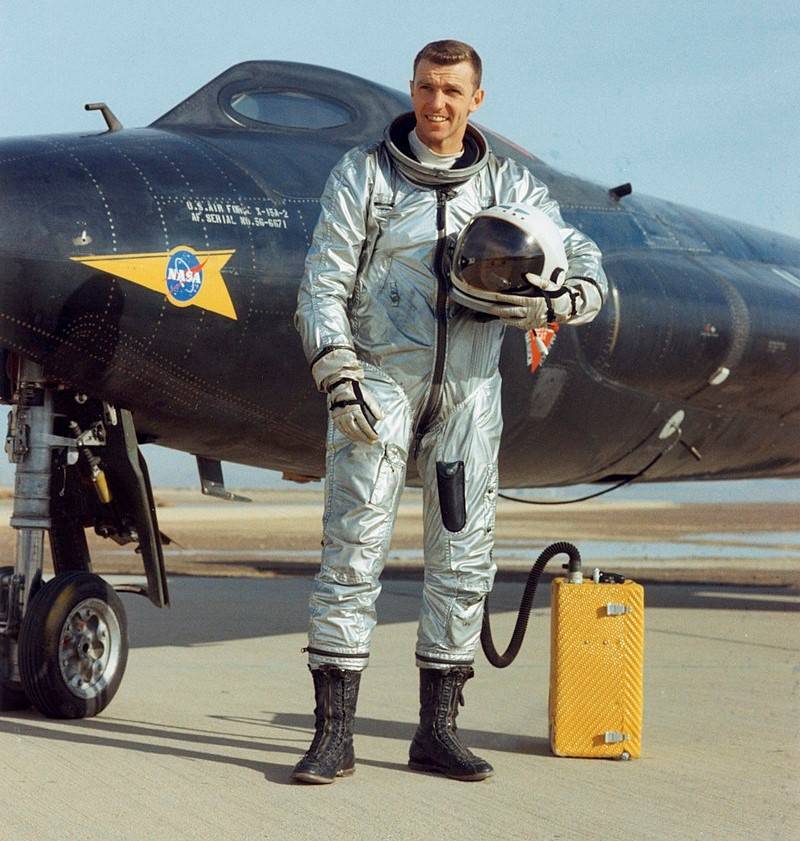
Left: NASA pilot Joseph A. “Joe” Walker stands next to an X-15 rocket-powered aircraft. Middle: NASA pilot Neil A. Armstrong stands next to an X-15 in 1960. Right: U.S. Air Force pilot Joe H. Engle poses next to an X-15 in 1965.
Of the 12 pilots, eight flew a combined 13 flights that met the U.S. Air Force’s criterion for human spaceflight by exceeding the altitude of 50 miles (80 kilometers), qualifying them as military astronauts. The five Air Force pilots earned astronaut wings immediately, while the three civilian pilots waited until 2005 to earn NASA astronaut wings. Of these 13 flights, two flown by the same NASA pilot, Joseph A. “Joe” Walker, met the criterion for human spaceflight established by the Fédération aéronautique internationale (FAI), or International Aeronautical Federation, by exceeding the von Kármán line at an altitude of 62.1 miles (100 kilometers). Walker reached an altitude of 67.1 miles (108 kilometers) on Aug. 22, 1963, the highest for any X-15 flight. Two of the X-15 pilots, Neil A. Armstrong and Joe H. Engle, later became NASA astronauts. Armstrong, selected by NASA in 1962, flew on Gemini VIII and took humanity’s first footsteps on the Moon during the Apollo 11 mission, while Engle, selected in 1966, commanded space shuttle missions STS-2 and STS-51I.
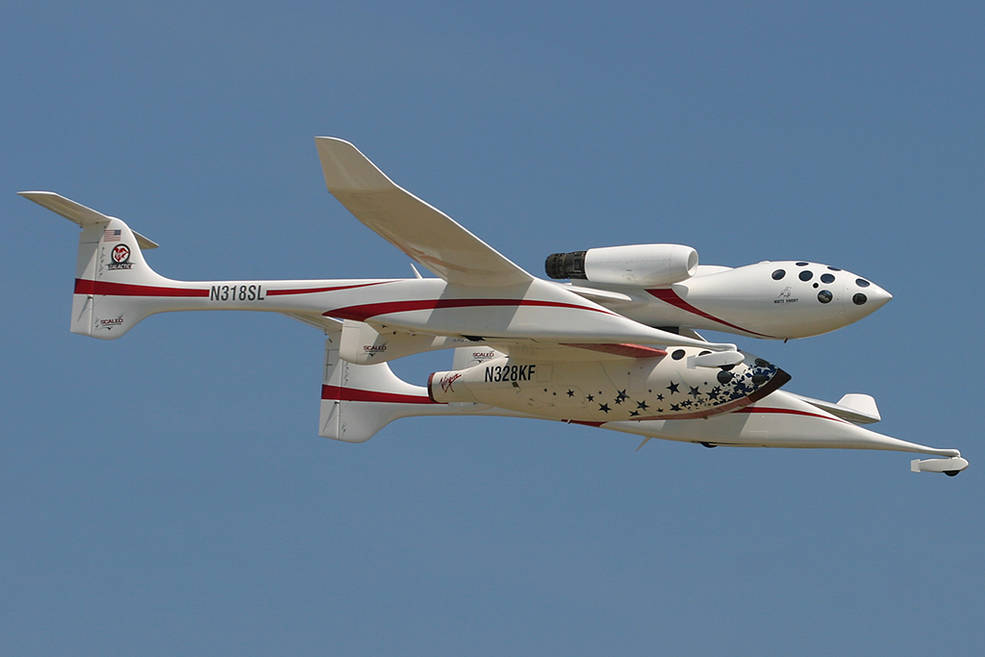
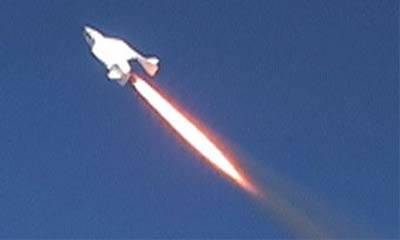
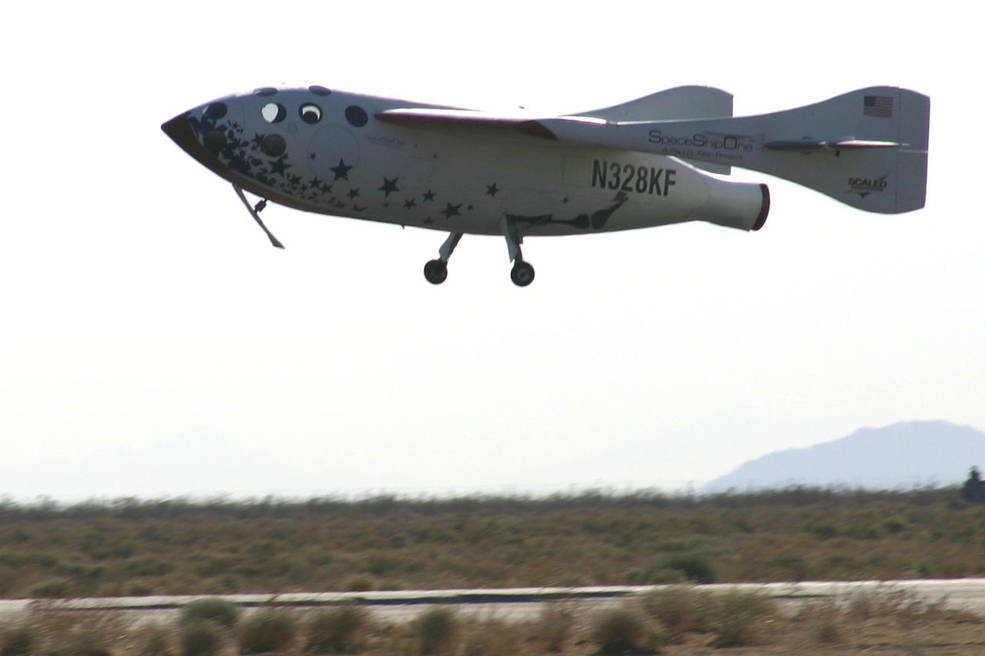
Left: The White Knight carrier aircraft carries SpaceShipOne to altitude. Middle: SpaceShipOne under the power of its rocket engine. Right: SpaceShipOne comes in for a landing.Image credits: Courtesy Scaled Composites.
Rocket-powered aircraft play a significant role in 21st century suborbital commercial spaceflight. Developed by Mojave Aerospace Ventures, a collaboration between aircraft designer Burt Rutan’s Scaled Composites and Microsoft co-founder Paul Allen, SpaceShipOne won the $10 million Ansari X-prize by completing two suborbital missions to an altitude of 100 kilometers using the same vehicle within two weeks. Carried aloft by Scaled Composite’s White Knight carrier aircraft, SpaceShipOne dropped away and lit its hybrid rocket motor to reach its designated speed and altitude. The first powered flight took place on Dec. 17, 2003, the 100th anniversary of the Wright Brothers’ first powered flight at Kitty Hawk, North Carolina, with pilot W. Brian Binnie at the controls. The first of the two X-prize qualifying flights took place on Sept. 29, 2004, with Michael W. “Mike” Melvill at the controls, followed by the second flight on Oct. 4, with Binnie piloting. Because both flights exceeded the 100-kilometer threshold, Melvill and Binnie received U.S. commercial astronaut wings. Rutan decided to retire SpaceShipOne after its prize-winning flight and begin concentrating on the next project.
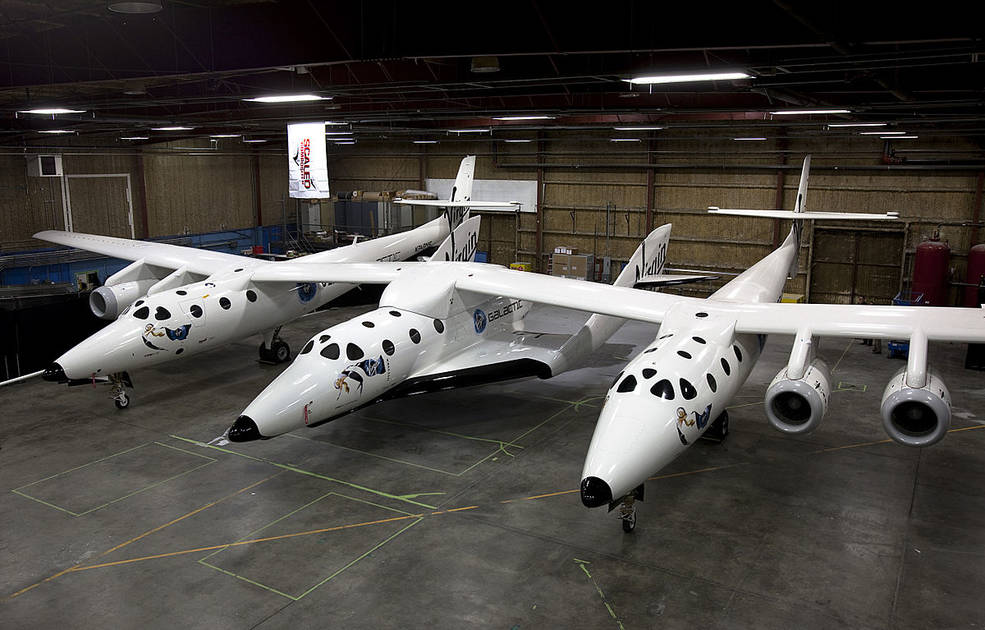
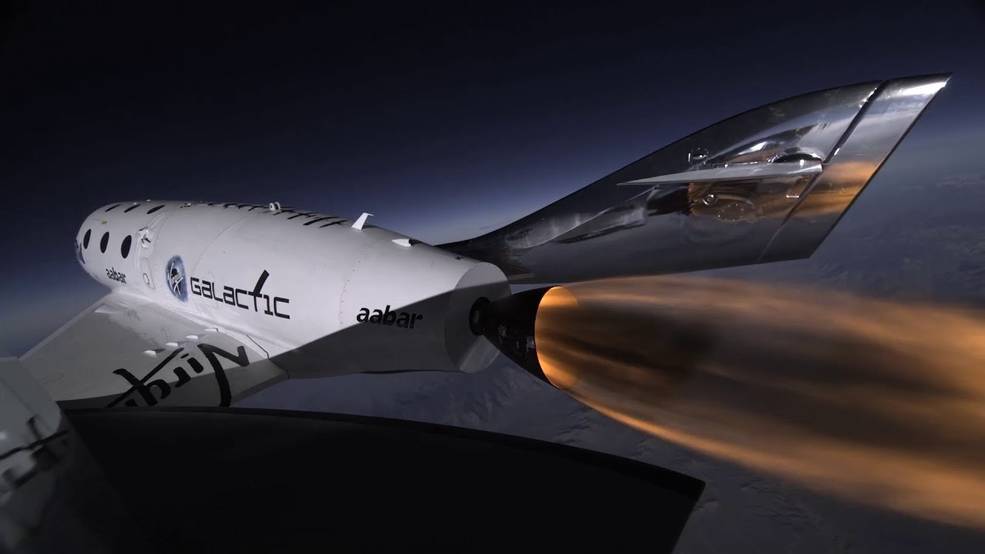
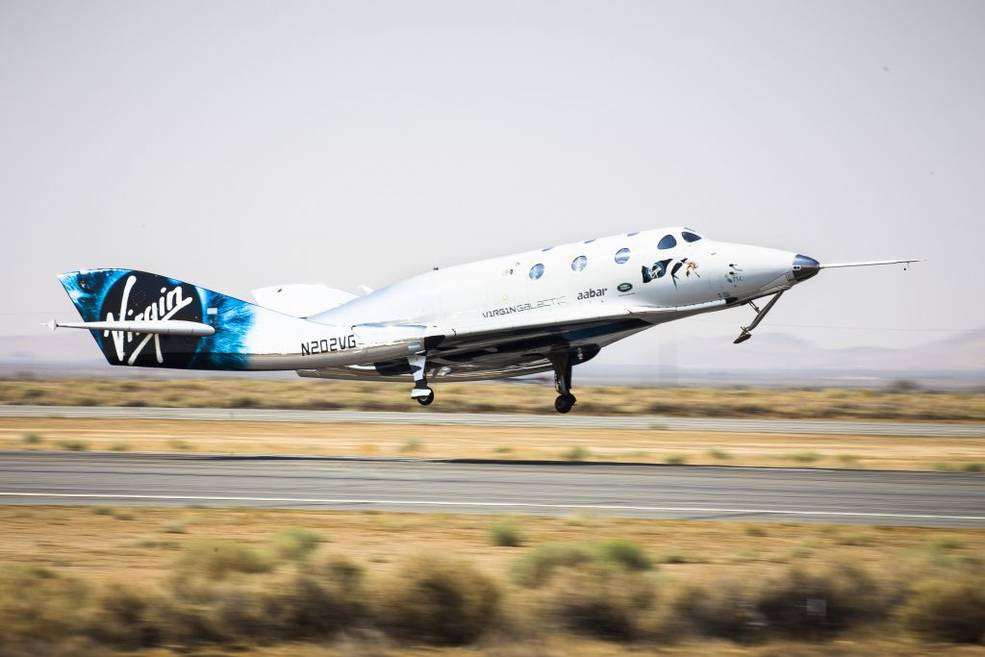
Left: The twin-fuselage White Knight Two carrier aircraft with the SpaceShipTwo rocket-powered aircraft, center fuselage. Middle: SpaceShipTwo with its engine lit following release from White Knight Two. Right: SpaceShipTwo touches down. Image credits: Courtesy Virgin Galactic.
SpaceShipTwo, roughly twice the size of its predecessor, can carry up to eight people – two pilots and six paying passengers – as well as payloads for NASA and other paying customers. Like its predecessor, a White Knight Two twin-fuselage airplane carries SpaceShipTwo to altitude, where after release it ignites its hybrid rocket engine to begin its suborbital trip into space. Unveiled in December 2009, the first SpaceShipTwo vehicle named Enterprise made its first powered flight on April 29, 2013. That airplane crashed on Oct. 31, 2014, killing one of its two pilots and injuring the other. The second vehicle, Unity, made its first powered flight on April 5, 2018, and its first flight above 80 kilometers on Dec. 13, 2018. The first flight to carry six people, including Virgin Galactic founder Sir Richard Branson, took place on July 11, 2021. Because that fight deviated from its planned course, the Federal Aviation Administration, the agency responsible for overseeing commercial space flights, suspended further SpaceShipTwo flights pending an investigation. Flights resumed on May 25, 2023, once again carrying six people, and further flights are expected.
John Uri
NASA Johnson Space Center






























